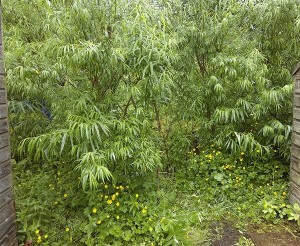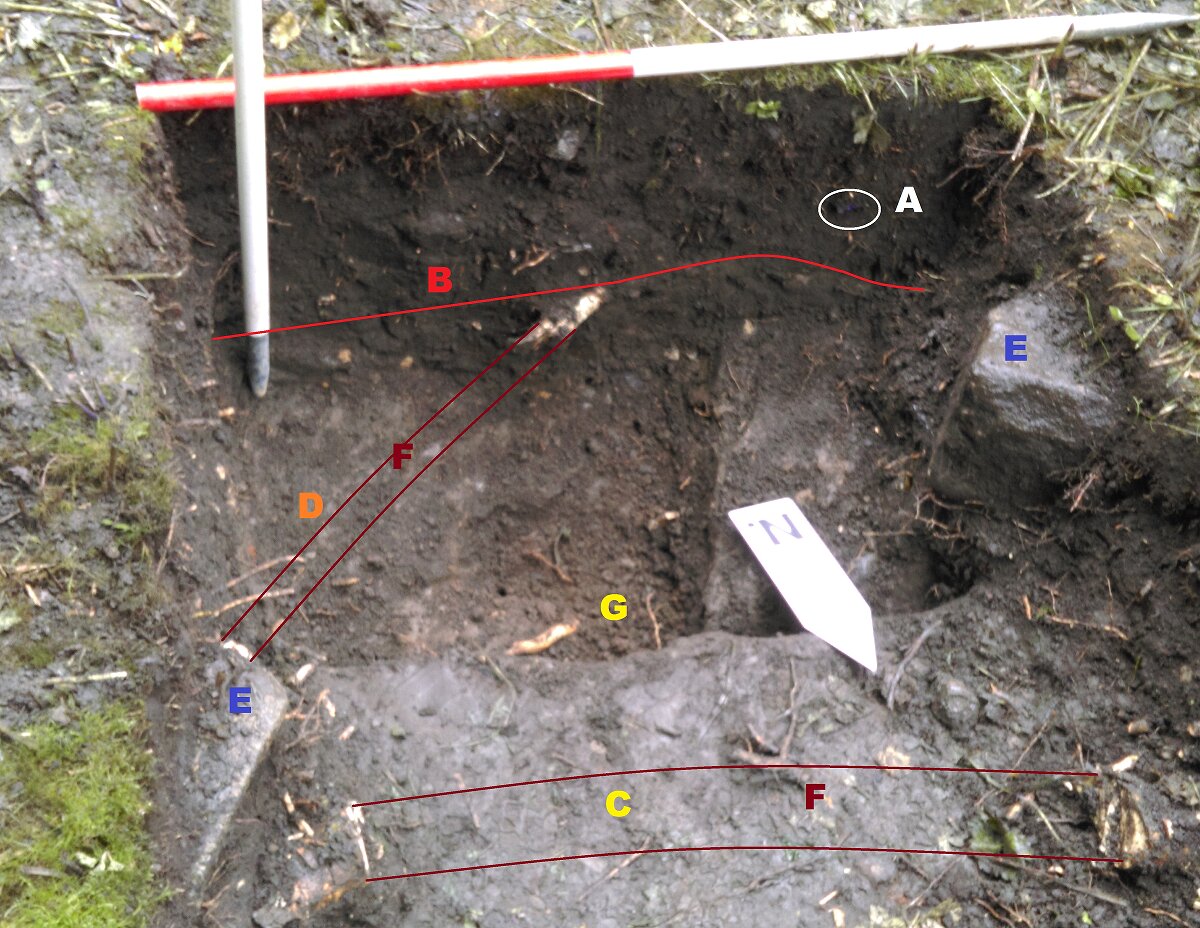Heritage Open Gardens and Strawberry Tea Archaeology Dig – 20 June 2015
The forecast was wrong – the sun arrived just after 4pm, when I was trying to type this with one hand desensitised by at least three hits of nasty Nelly the nettle. Aah the hazards of extreme archaeology.
 A few months ago the archaeology group were invited to do a dig as part of Heritage Open Gardens and Strawberry Tea day. We eventually plumped for a trench over the possible course of the local stream before it was diverted around the walled garden. When we initially saw the site it seemed open & friendly – the greener photo shows what greeted us on the day. We cleared a path into the primordial vegetation then chopped out a clearing (ouch ouch ouch) and opened a 1 metre square trench.
A few months ago the archaeology group were invited to do a dig as part of Heritage Open Gardens and Strawberry Tea day. We eventually plumped for a trench over the possible course of the local stream before it was diverted around the walled garden. When we initially saw the site it seemed open & friendly – the greener photo shows what greeted us on the day. We cleared a path into the primordial vegetation then chopped out a clearing (ouch ouch ouch) and opened a 1 metre square trench.
 The jungle theme continued as we worked in constant drizzle, brightened by occasional heavy showers. I will now refer you to the other photo & we will proceed by letters (all the right letters but not necessarily in order). Almost immediately we were onto the blue Es. There were three of these all at the same level & indicate the site of something within very recent history, possibly a shed or pen. These were set entirely in the top soil, which is over a foot (300mm+) deep. Our way was hampered by the two maroon Fs – a pair of rather thick roots (delineated by the maroon lines) that had to be removed by axe. They were cut cleanly & should heal well without any adverse effect on the tree. We were disheartened to find a modern choccy bar wrapper (white A) at over 200mm deep. A number of pottery sherds were found in the top soil. Nothing is pre Victorian from this stratum, the majority probably from the twentieth century.
The jungle theme continued as we worked in constant drizzle, brightened by occasional heavy showers. I will now refer you to the other photo & we will proceed by letters (all the right letters but not necessarily in order). Almost immediately we were onto the blue Es. There were three of these all at the same level & indicate the site of something within very recent history, possibly a shed or pen. These were set entirely in the top soil, which is over a foot (300mm+) deep. Our way was hampered by the two maroon Fs – a pair of rather thick roots (delineated by the maroon lines) that had to be removed by axe. They were cut cleanly & should heal well without any adverse effect on the tree. We were disheartened to find a modern choccy bar wrapper (white A) at over 200mm deep. A number of pottery sherds were found in the top soil. Nothing is pre Victorian from this stratum, the majority probably from the twentieth century.
Below this was a stratum containing a lot of burnt material, typical of fire place discard. The top of this layer is defined by the red line at B. The majority of the finds in this stratum were of similar date to the pot sherds in the top soil. Two possible exceptions were a couple of sherds of blackware that may date to before the Industrial Revolution. These have only been examined in an unwashed state but appear to exhibit characteristics typical of vessels dating to between c1600 & c1760 AD. Both of these were found at the interface between the burnt layer and the top of the clay below. This brings us to the yellow C & the orange D.
Both C & D were under B (keeping up?) and were devoid of any finds. C extended across the whole trench except for the corner marked by D. D shows hallmark signs of being created by tree roots & excavation produced no evidence to the contrary & no indication of date. C is clay. This can be regarded as the natural as it is glacially deposited & contains no finds. The clay is very fine grained and dense – it would probably pot quite well. Some probing was done into the clay layer & gave the impression that the clay continued, with occasional gravel lenses, to beyond the extent of the probe. We dug a small sondage at G and this was confirmed though we only went down another 200mm or so.
We may not have found the expected water channel but other things were revealed. The lack of any real age to the archaeology shows that this part of the site was not used by the house – there were not even any of the usual traces left by Victorian & Georgian gardeners. Not even a single pipe fragment. The evidence of root intrusion into the clay suggests that the area was wooded until at least the late Victorian period. This is borne out by map regression. In this case the absence of evidence can be safely construed as evidence of absence. Activity at Park Hill was confined to the north of our dig site & the stream was not diverted through the site of our excavation. If you thought this dig didn’t go back very far into history, look up when the last Ice Age reached Pendle. That was very old muck on our boots.
If you are one of the surprisingly large number, given the miserable conditions, of visitors to the dig you will probably have heard a lot of this already. We thank you and everyone reading this, for your interest & would like to encourage you to join the Friends & come along on some of our other archaeological adventures. I can guarantee you will discover something old anew.
Alex Whitlock 20/06/2015

